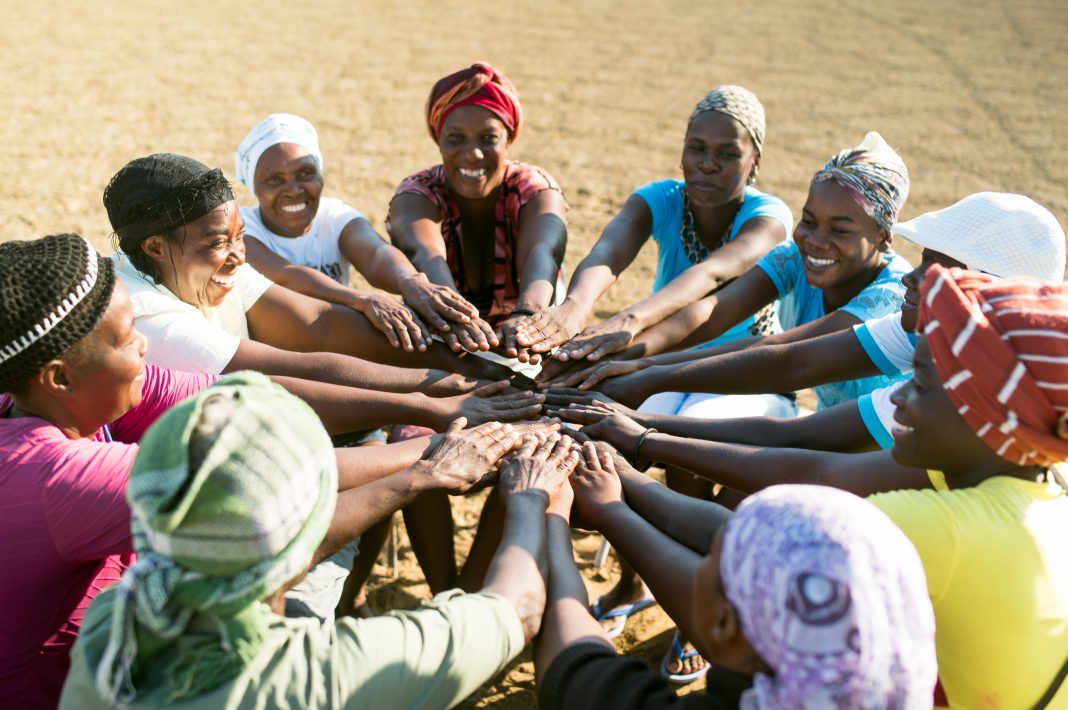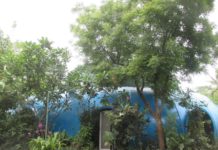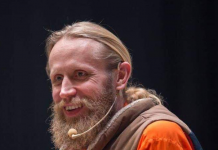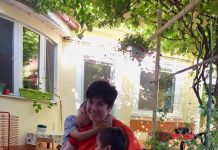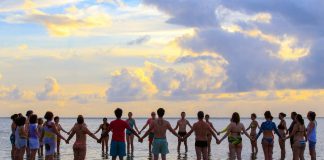AMURT’s strategies in Haiti have focused on two strong pillars of development: education and social entrepreneurship (PROUT in practice). The organization has responded to the earthquake that struck the country in 2010 through a 2-year long intervention focused on emergency education for 3000 children living in some of the most difficult refugee camps in the capital. Gradually, the vision of the programs evolved to include professional development for teachers, in particular child-centered neo-humanist methodologies.
By 2014 AMURT entered in partnership with Haiti’s most recognized higher education institution, Universite Quisqueya, and established InnovEd – the Innovative Education Institute (www.innoved.uniq.edu). Sarita (Sara Wolf), InnovEd’s programs coordinator and pedagogical developer, describes InnovEd’s pedagogical model – the “vibrant school” – as a community focused on joyful and spontaneous exploration and sharing of growth and experiences. “Before, I was a robot who talked all the time. Now, thanks to InnovEd, I engage students using participation strategies,” says one of the participating teachers, in one of the independent evaluations. “Before, I was the only person who talked in my class. And I was the boss who beat students constantly. Today, InnovEd has changed me” says another.
Even before introducing innovations in the field of educational, AMURT-Haiti has been working since 2004 to improve the quality of life of Commune Anse Rouge through an integrated and participative development model. Anse Rouge is situated in the economically and socially isolated and environmentally devastated corner of the island. Sustained soil erosion and deforestation coupled with persistent drought and threats from hurricanes, as well as the virtual lack of services and even basic infrastructure have resulted in a very hostile environment where there is no government and NGO presence.
Dharma (Demeter Russafov), the Country Director of AMURT-Haiti, shared that it is these very hostile conditions and incredibly high local needs which motivated him to lead the establishment of AMURT’s programs in the country. He first came to Haiti as a LFT (volunteer in preparation for a yogic-monk lifestyle) in 2004, drawn to the challenges it posed and the simplicity and beauty of its people. Within a few months after arriving and helping build a school in Port-au-Prince, the flashfloods of Hurricane Jean left a devastating path of destruction and death and pushed much of the country in crisis. After hitching a ride on a truck Dharma reached the most isolated region affected by the floods, Anse Rouge. Once he connected with the local communities and understood their needs, within a week he had convinced the World Food Program to support the newly established AMURT, and his young team of Haitian LFT volunteers began offering hot meal canteens and psycho-social programs to 4000 children and elderly in 6 villages.
At dawn one night, awakened by the noises he regularly heard, he stepped out of his tent and saw the silhouettes of caravans of children walking across the desert with empty jugs on their heads. He followed them all the way to a water source situated miles away higher in the mountains, before returning with the kids just in time for them to get ready for school. He quickly discovered that the lack of water in the coastal villages was due to a decade-old water conflict between villages that resulted in the destruction of the water system. Dharma decide that the main focus of his team of volunteers and local residents would be the rehabilitation of the water system. They were successful and, thus, they gained the trust of the local communities as well as government and funding agencies, and the reputation of AMURT began growing year by year.
The outcomes of AMURT’s multitude of interventions include more than a million trees planted, dozens of watersheds and ravines preserved, several schools and clinics built, and irrigation canals and water reservoirs providing water and helping turn desert land in cultivable farms. Yet it is the innovations in salt production that has become AMURT’s most important and potentially transformative achievement.
By observing the difficulties faced by traditional salt producers as they tried to eke a living out of deep mud holes filled with sea water, Dharma and his team of volunteers became aware of the incredible complexities associated with salt production in Haiti. Women salt harvesters managed to extract only two salt harvests per year in very hazardous and difficult conditions, and the quality and quantity of salt was very low and full of impurities. At the same time, iodine deficiency disorder is a major health problem for 50% of the Haitian population, causing severe health consequences.
Salt production in most countries efficiently evaporates sea water in shallow interconnected basins, and results in 32 annual harvests of high quality salt. Dharma knew that this efficient salt production would prove a game changer not just for Anse Rouge but for country’s fight with iodine deficiency. To address this, he first focused in gradually building the community trust and organizational structures, especially those of the most vulnerable, the women.
The model they chose to adopt focused on creating Self-Help Group (SHG): networks made of groups of women of low socio-economic status. An SHG is made of twenty women who meet weekly, create their own rules, and make regular contributions to a loan fund used to offer micro-loans to members. Women discuss their problems in groups and find solutions together, increasing their solidarity, and solving conflicts and challenges. According to one participant, Marie-Anette, 32, a single mother of three, before AMURT started with self-help groups, women were at the bottom of society. “I can’t tell you how often I heard about women being beaten, women not wanting to leave their husbands because they had nowhere to go. Now we are 250 women in our village alone – organized and much stronger together”, she says. After 6 years since the first SHGs were started, there are now more than 3,000 women organized in 160 groups, with more than 195,000 USD in self-generated microcredit funds.
In these groups, women are introduced to breathing practices and yogic movements to manage stress. “It’s a psycho-social process of shared practices. Meetings begin by sharing a moment of silence, closing our eyes and connecting with the power of the heart,” says Dharma. He emphasizes these practices are introduced in a very subtle way, so as not to reinforce a prevailing idea that yoga might be a religion.
The SHG method supports three pillars of rural society: economic, social and political. The groups send representatives to form the next representational level: the associations, which eventually elect representatives to form the third and highest level – the federation. Rotational leadership assures the group elects its representatives in the associations and the federation. When a federation is formed, it represents 4,000 organized women, creating a highly efficient rural organization model, that AMURT wants to replicate in other parts of Haiti.
This progressive community organization is the basis of the salt production cooperative (ESPRI). The social enterprise reinvests its profits in capacity development and microcredit for women SHG members. As Violet, a 36-year-old SHG member and salt harvester says, “it’s not just a new way of producing salt, it’s a new way of living.”
Editorial Staff
Do you want to recommend a project for #dharmapracar? Write us at journal@d4all.org.



